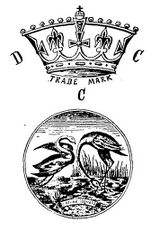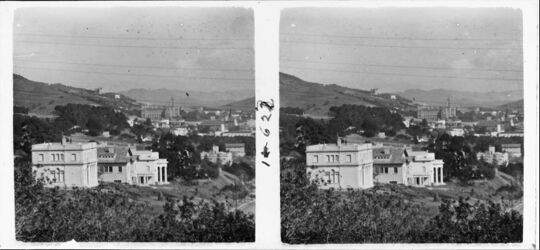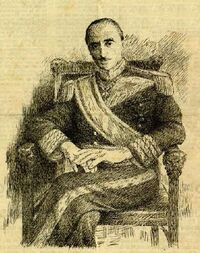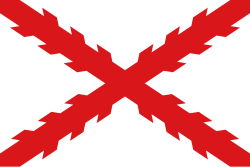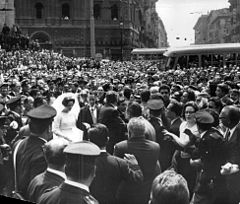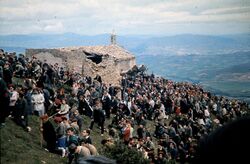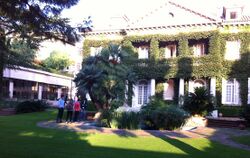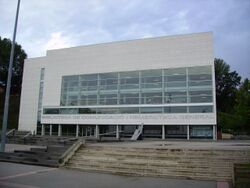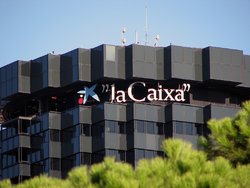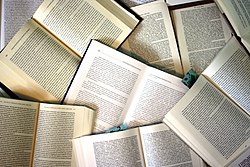Biography:Ramón Massó Tarruella
Ramón Massó Tarruella | |
|---|---|
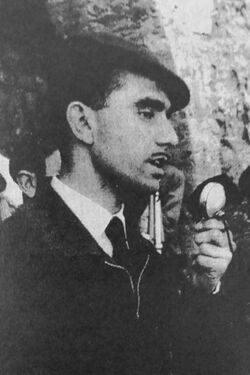 | |
| Born | Ramón Massó Tarruella 1928 Pallejà, Spain |
| Died | 2017 |
| Nationality | Spanish |
| Occupation | scholar, entrepreneur |
| Known for | media expert, politician |
| Political party | Carlism |
Ramón Massó Tarruella (1928-2017) was a Spanish media and communications expert, known also for his role in Carlism of the 1960s. He gained nationwide recognition in the 1970s and 1980s, when as academic, theorist and brand communications specialist he published numerous books and co-ran a media agency. In historiography he is moderately recognized for his role in politics of mid-Francoism. He was leading the group of young Carlist activists who challenged the Traditionalists and eventually ensured domination of the progressist current. However, his bid to promote prince Carlos Hugo as a future monarch and as an alternative to prince Juan Carlos failed.
Family and youth
Massó descended from an established, well-to-do Catalan bourgeoisie family. His grandfather Ramón Massó Marcer (died 1936)[1] originated from a seaside town of Sant Pere de Ribes.[2] In 1885, during rapid expansion of the Catalan textile industry, he moved to Barcelona to set up his own business. He started a company which specialized in production of textile dyes;[3] fairly successful,[4] in 1902 it was turned into R. Massó y Cía, Sociedad Colectiva.[5] His son, Juan Massó Soler (died 1975), entered the family business in 1912 and developed it into a diversified chemical company.[6] Massó Soler also owned real estate in the then suburban Barcelona zone of Pedralbes.[7] He was member of many Catalan commercial and trade institutions, e.g. Sociedad Economica Barcelonesa de Amigos del País[8] or Asociación de Químicos Textiles.[9] At unspecified time, though probably in the mid-1920s,[10] he married Nuria Tarruella Riu;[11] the couple lived in Pedralbes, in the luxury Massó mansion at Avenida Pearson.[12]
Juan and Nuria had 8 children, 3 sons[13] and 5 daughters,[14] all raised in deeply Catholic[15] and moderately conservative ambience. There is nothing known about the early schooling years of Ramón, which occurred in the early 1930s.[16] Following outbreak of the civil war and in circumstances which are not clear the Massó family left the revolution-engulfed Barcelona and somehow made it to the Nationalist zone;[17] they settled in San Sebastián.[18] After the end of hostilities the family returned to Barcelona,[19] where Massó Soler resumed his chemical business. None of the sources consulted provides information whether in the mid-1940s the young Ramón – who turned 18 in 1946 - was studying or perhaps he got engaged in the family enterprise. Some time in the late 1940s he moved to Madrid and enrolled at the Filosofia y Letras faculty in Universidad Central.[20] He got a degree in philosophy with a thesis on "temas pedagógicos de innovación educativa";[21] the year of Massó’s graduation is not clear, though it was likely 1954.[22] In the mid-1950s[23] he moved to Bilbao to commence teaching at Colegio Gaztelueta,[24] a school founded few years earlier by Opus Dei (Massó entered Opus in 1948)[25] and the local high bourgeoisie of Getxo.[26]
Massó has never married and had no children. His brothers José Luis and Juan Antonio joined the family company. In the 1960s José Luis, acting as co-owner and CEO, turned it into Comercial Química Massó Sociedad Anónima, which expanded into new market sectors and remains active until today;[27] he was also known as engaged in the Barcelona football club, RCD Español.[28] The youngest brother Juan Antonio left the world of business and commenced studying canon law; he was ordained as a priest in 1965. Following his transfer to Australia he later became the Regional Vicar of Opus Dei, the position retained until his death.[29] Another known Massó’s relative was his distant paternal uncle, Ramón Oliveras Massó; a chemist, in the early 1930s he was director of the Barcelona-based Escuela de Ingenieros Industriales[30] and taught there until 1936.[31]
Early Carlist engagements (until 1955)
Massó’s father politically was related to moderate Catalanist conservatism and held minor posts in Lliga Regionalista.[32] Later in Francoist Spain he approached[33] and possibly even joined Carlism,[34] but until the civil war there were no Carlist "antecedentes familiares".[35] Hence, it is not clear what mechanism was at work when Ramón, at the time a 9-year-old, during the wartime exile years in San Sebastián joined the Carlist juvenile organisation, Pelayos. When in aftermath of political Francoist amalgamation it was merged with the Falangist youth branch Flechas Massó withdrew. As a boy he took part in the 1937 anti-unification demonstrations, shouting "death to Franco" and "death to Falange".[36] Having returned to Barcelona he remained active in informal Carlist youth structures[37] and attended Carlist rallies; according to his own later account it was during the 1945 Montserrat aplec that he became determined to act whatever it takes.[38]
During his academic years at the turn of the 1940s and 1950s Massó found himself part of a wave of young Carlist students, active in Madrid.[39] They were increasingly irritated by what they perceived as complacent, somnabulic atmosphere of Carlist círculos.[40] He was neither impressed by theoretical works by Traditionalist pundits like Rafael Gambra,[41] which he found intellectually refined, but of little practical value.[42] He was rather fascinated by José Ortega y Gasset and his vision of politics as action;[43] he formatted his Carlist vision as activism pushing the limits of what was possible.[44] He did not attend courses of the Carlist Academia Vázquez de Mella,[45] though he joined Agrupación de Estudiantes Tradicionalistas, a technically illegal though tolerated Carlist student organization.[46]
Enraged by increasing marginalization of Carlism within Francoist Spain, Massó developed his childish anti-Falangist sentiments into a firm anti-Francoist outlook. In the early 1950s together with other AET activists he engaged in leafleting campaigns against Sindicato Español Universitario, the official and the only legal academic organisation;[47] he took part also in rallies and minor skirmishes against the SEU members, which eventually produced dismissal of the SEU president, Jorge Jordana de Fuentes.[48] In 1952 for the first time he had the opportunity to meet the Carlist claimant Don Javier; Massó took part in a banquet which accompanied the Eucharistic Congress in Barcelona, where the pretender made some political declarations.[49] He gradually emerged among the Madrid AET leaders. In 1954[50] (according to some sources in 1955[51]) the Carlist political leader, Manuel Fal Conde, nominated him Delegado Nacional de la AET, the leader of the organisation.
Launch of Carlos Hugo (1956-1961)
In the mid-1950s Massó served as a link[52] between AET members in Bilbao and Madrid.[53] Disturbed by rumors of possible reconciliation between the Alfonsist and Carlist claimants, in early 1956 they met Don Javier en transit in Bilbao; during extremely emotional encounter[54] they tried to dissuade him from a dynastical union.[55] At the 1956 annual Montejurra rally Massó as AET representative spoke for the first time, and against somewhat reserved and vague monarchism of the likes of Zubiaur,[56] he openly hailed "Rey Javier".[57] However, disappointed with claimant’s ambiguity, the Massó-led aetistas have already decided to focus on his eldest son Hugues,[58] with whom the group found common ground during his earlier brief stay in Madrid.[59] Settled in Bilbao, since late 1956 the prince was being introduced to Carlism by the Massó-led team[60] until he made a public debut during the annual Montejurra amassment in 1957. The entry, repeatedly rehearsed,[61] meticulously planned and pre-agreed with the Carlist leadership,[62] turned out to be a masterpiece of public appearance.[63] Massó and his team ensured that La Proclama de Montejurra gets propagated in Carlist circulos across Spain.[64]
The address of prince Hugues sounded like an offer to Franco. Massó crafted it as part of "colaboracionismo táctico", a strategy of ill-willed collaboration with Francoism in order to gain room for further action;[65] it was opposed to "colaboracionismo puro", promoted since the mid-1950s by the new Carlist leader, Valiente, who sincerely hoped for some sort of prudent partnership between Francoism and Carlism.[66] However, the fiercely anti-Francoist AET rank-and-file did not distinguish between such subtleties and in late 1957 Massó was deposed[67] from leadership of the organisation.[68] Nonetheless, he continued along the same path; during the 1958 Montejurra in another Massó-written address Hugues reiterated vaguely pro-Francoist themes, combined with focus on social issues.[69] The same year the prince asked Massó to settle in Paris and run his future political secretariat, the proposal he declined.[70]
During the AET congress in 1959 Massó advocated his strategy of limited collaboration, enveloped in a vision of renovated, socially sensitive Carlism;[71] it failed to get him a place in the executive.[72] He shifted attention from AET to building a following for prince Hugues, with ambitious plan of "intentar la conquista del Estado" in the background.[73] At the turn of the decades he took place and organized numerous public Traditionalist acts mobilizing support,[74] including address at the 1960 Montejurra[75] or lecture during Semana Nacional de Estudios the same year.[76] He was also behind the action of re-positioning prince Hugues as "Carlos Hugo", with reference to iconic Carlist name.[77] He convinced the prince to settle permanently in Madrid; the latter still wanted him to head his secretaría política, but because of opposition on part of his Opus Dei superiors, Massó initially declined.[78] It was only in 1961[79] that the prince took up residence in the capital;[80] Massó quit his job in Bilbao, also moved to Madrid and as secretario paricular he became "sombra inseparable" of Carlos Hugo.[81]
Head of secretaría (1961-1965)
Massó became head of Carlos Hugo’s secretaría política, a team composed mostly of people in their 20s. The group, dubbed "camarilla",[82] focused primarily on promotion of the prince as the would-be king of Spain; the campaign was clearly calibrated against prince Juan Carlos, who at the time was gradually emerging as potential Franco’s successor and the future monarch. They posed as allies of the regime and seemed aligned with Valiente’s collaborative approach; the strategy partially worked and the carlohuguistas were allowed to launch an array of periodicals; Massó published especially in Azada y Asta,[83] though he edited also Información Mensual.[84] and collaborated with Montejurra.[85] The group used these titles as platforms for advocating what they presented as a new, progressist version of Carlism. They were posing as faithful partisans who either merely sought "agiornamento" of the doctrine, or who focused on the genuine, socially-minded basis of the movement.[86]
Already in the early 1960s Massó-led secretaría found themselves suspected of nurturing subversive, progressist, anti-Traditionalist ideas.[87] He claimed to have been a renovator of Carlist orthodoxy and avoided open confrontation with Traditionalist core of the movement; his memoranda which advocated change focused rather on technical, not ideological issues.[88] In 1962-63 Massó skillfully outplayed his chief opponent, José Luis Zamanillo, and got him expelled;[89] he also worked to isolate other groupings, like Siempre.[90] A series of prince-supported reorganizations in the party followed; they diluted power in the top party layer. In 1963 the Massó-led secretaría effectively took control of the main office;[91] though not holding any post in the executive, he became of the key party decision-makers. From this moment on the carlohuguistas spelled out their vision of Carlism more openly; in 1964 they published a progressist ideological lecture, Esquema doctrinal.[92]
The ideological catch-phrase advanced across Spain was "monarchy of July 18",[93] but Massó formatted the 1961-1964 public campaign in favor of Carlos Hugo rather as a series of "golpes de efecto",[94] a communication strategy engineered to target the emerging consumer society. Apart from touring Spain in various engagements,[95] the prince was portrayed as a miner in Asturias,[96] attendee of a parachuting course,[97] or mozo running with the bulls in Pamplona;[98] his sisters, all in their 20s, were also exploited mediatically.[99] The greatest media scoop, however, was the 1964 wedding of Carlos Hugo with princess Irene of the Netherlands.[100] Massó hoped to win Franco and the Spanish public opinion against prince Juan Carlos;[101] at this point, however, the regime propaganda machine was firmly ordered to backtrack. Franco grew increasingly anxious that the popularity of Carlos Hugo might get him cornered when it comes to an inescapable dynastical decision. National media played down the event.[102] Apparently unabated, Massó kept working to obtain Spanish citizenship for the prince.[103]
Disengagement (1965-1967)
In the mid-1960s the Massó-led camarilla appeared largely in control of the Comunión,[104] dubbed its "parallel executive".[105] The isolated traditionalist leader, Valiente, approached Solis for the Cortes mandate for Massó[106] and considered him his potential successor.[107] When speaking at the 1964 Montejurra gathering Massó delivered "one of the most vehemently critical speeches pronounced up to then in a public event in Spain".[108] Though he did not speak in 1965, this year the carlohuguistas almost abandoned their declared allegiance to tradition and voiced praise of socialism at unprecedented levels;[109] the event is at times dubbed as the "swan song" of the secretaría.[110] According to some historians there might have been some cracks within the group, with José María Zavala reportedly representing "sector popular" against the moderated faction represented by Massó,[111] but others tend to treat carlohuguistas as fairly homogeneous.[112] In 1965 the secretaría was at its peak,[113] and Massó assessed that the balance of power between the progressists and the traditionalists was 90:10.[114]
It came as a shock to most in the Comunión when in 1965 Massó declared that he was about to leave the secretariat and move from Madrid to Pamplona,[115] where in the autumn[116] he was scheduled to take a teaching post in Universidad de Navarra, a newly created Opus Dei institution.[117] There are various motives quoted in historiography; some claim he got disillusioned with the prince and his wife, who demonstrated a bourgeoisie mentality,[118] but most scholars tend to agree he realized the project of launching Carlos Hugo failed,[119] that the regime would never grant him Spanish nationality and mediatic campaign would not overweight Franco’s political preferences.[120] In early 1966 he met Don Javier in Hendaye; the claimant accepted his resignation,[121] and secretaría política was dissolved altogether.[122] According to some, 1966 marks a ruptura between Massó and Carlos Hugo,[123] though the two kept corresponding in 1967.[124]
Massó considered a new opening. He contemplated provoking an expulsion of Carlos Hugo, which would leave the prince free to embark on anti-regime propaganda, but his suggestions were not acted upon.[125] He limited himself to labors in the local Navarrese milieu, e.g. in 1966 he helped to secure a place of the new El Pensamiento Navarro editor-in-chief for a young progressist, Javier Pascual Ibañez.[126] The claimant explicitly asked him not to engage in open politics.[127] In the spring of 1967 Massó was busy preparing another annual Montejurra ascent in May, but shortly afterwards he and a number of his collaborators from the former secretaría published a widely reproduced[128] open letter. It declared resignations from the party and "the so-called monarchist cause".[129] The reason listed was anti-democratic stand adopted by the claimant dynasty, and especially its opposition to religious liberty.[130] Various authors speculate about other reasons, listing pressure of the Dutch court,[131] failure of the Carlos Hugo project,[132] financial matters,[133] Borbón-Parma support for Franco,[134] mistrust on part of Don Javier and his son,[135] having "burnt themselves out"[136] or even matters of the heart.[137] The role of progressist leader was assumed by Zavala.[138]
Academic and media pundit (1967-1975)
Having settled in Pamplona in the mid-1960s Massó commenced work as academic teacher in Estudio General de Navarra, founded by Opus Dei and recognized as a private university; none of the sources consulted provides detailed information on his exact teaching role.[139] His relations with Opus in the late 1960s are clear neither. Some scholars claim that until the mid-1960s he provided a personal link between Carlism and Opus,[140] the two highly mistrustful about each other.[141] However, reportedly he was getting increasingly disillusioned, not least because of the opusdeista technocrats supporting Juan Carlos.[142] This information does not match data about very strong links of the Massó family with the organisation. In the late 1950s his parents were financially involved in setting up Instituto de Estudios Superiores de la Empresa (IESE), a prestigious post-graduate business school founded by Opus in Barcelona; in the mid-1960s they sold below the market price some real estate, where IESE built its premises.[143] In the late 1960s IESE started to offer its courses within the Estudio General de Navarra framework, and Massó was engaged in its works. He also completed the Alta Dirección curriculum himself, a holistic leadership program offered to top corporate managers.
It is not clear when exactly Massó broke with Opus Dei; most sources point to the year of 1967,[144] yet it is known he kept teaching in the Pamplona opusdeista institutions until the late 1960s. At unspecified time, probably at the turn of the decades, he left Pamplona and returned to his native Barcelona. In the early 1970s he completed the classes organized by Instituto Nacional de Publicidad[145] and in 1972 he officially became "Técnico en Publicidad".[146] Some time in the early 1970s he joined Universidad Autónoma de Barcelona (UAB), where he started giving classes of publicidad in Departamento de Publicidad at the Facultad de Ciencias de la Información.[147] In 1973 he was already recognized as an expert in the field of advertising, marketing, communications and media, and featured in the press when presiding over international conferences related,[148] two years later speaking along world-recognized gurus like Marshall McLuhan.[149] He started to feature in jury of various media-related prizes, e.g. in 1974 as representative of the Barcelona mediatic milieu in presidency of Premio Gardoqui, a prize awarded by the opusdeista publishing house SARPE,[150] or in 1975 as representative of UAB in presidency of Gran Premio Laureo, awarded by the Barcelona Hoja de Lúnes.[151] His area of expertise was far beyond advertising in the printed media; he also voiced on marketing in cinematography, e.g. in 1975 debating at Festival de Cine Publicitario Iberfilm.[152]
Communications expert (after 1975)
In 1976 Massó returned to politics as an expert. He co-founded ALAS,[153] one of the first media agencies in Spain, and became head of its Barcelona branch;[154] its focus was not on promoting commercial products, but on promoting politicians. The same year and jointly with J. E. Nebot[155] he published Introducción to ‘politing’. Lanzamiento de un aspirante.[156] The book was formatted as theoretical lecture on basics of political marketing, though it contained many references to the 1957–1967 political experiences of the author, and relative success of launching Carlos Hugo became one of Masso's key credentials as a scholar in public relations.[157] The work gained numerous prizes (Premio Markedit, Premio Instituto Nacional de Publicidad)[158] and generated interest among academics, politicians and commentators. Its catchword was "politing", Massó’s invention intended to denote a merger of politics and marketing. He followed up with other works on public relations, Estrategia para unas extrañas elecciones (1977)[159] and De la magia a la artesanía: el politing del cambio español (1980).[160] As expert he was contracted by La Vanguardia and until the mid-1980s he remained its key politics and public affairs commentator.[161]
The late 1970s and the early 1980s was the period of Massó’s top popularity as expert in media, marketing, advertising, brand communications and public relations. He engaged in numerous publishing initiatives, either these related to ALAS or to other institutions; e.g. together with his old collaborator from secretaría, José Antonio Parilla, Massó set up a publishing house Nono Art, and co-ordinated work on a popular series Breu História de Catalunya (1979–81).[162] He later claimed authorship of the La Caixa brand,[163] launched in 1982, though the company claims the author of the logotype was Joan Miró.[164] As a nationwide recognized scholar and apart from his academic role in UAB, he was giving courses organized by Sociedad Española de Anunciantes, Instituto Nacional de Publicidad or Escuela Oficial de Radio y Television.
In 1989 Massó co-founded the Barcelona-based Institut de Comunicació Integral, an independent college specializing in marketing, brand communications and public relations, and became its president.[165] It was supposed to focus on combined multidimensional holistic channels of information exchange, which he named "integral communication". ICOMI turned out to be a commercial (though not necessarily scientific) success and became a fashionable educational institute.[166] He published further works on communications: El exito de la cultura light (1993),[167] Noticias frente a hechos (with García-Lavernia, 1997),[168] Los últimos días de la Telecracia (with Nebot, 2009),[169] and Nacimiento y muerte de las marcas (with García-Lavernia, 2010).[170] Otro rey para España (2004)[171] was more of an account from his Carlist episode, while Navegando por el cachondeo de la historia (2012)[172] approached an autobiographic format.[173] He maintained scarcely active Twitter[174] and Facebook[175] accounts. Since the 1990s Massó renewed his links with carloshuguista groups, e.g. during prince Carlos Javier visits to Spain,[176] during conferences,[177] or extensively briefing PhDs hopefuls, who were writing their dissertations on Carlism of the 1960s.[178]
In historiography
In mainstream historiography dealing with the Francoist era Massó is barely noticed.[179] However, in works dedicated to history of Carlism of the time he appears as one of key figures, mentioned either as a protagonist or a source 21 times (García Ríol),[180] 22 (Caspistegui),[181] 44 (Miralles Climent),[182] 46 (Lavardin),[183] 111 (Vázquez de Prada),[184] 159 (Rodón Guinjoan)[185] and 189 (Martorell Pérez).[186] With few exceptions[187] he is almost unanimously identified as the leader of the progressist group, which challenged the traditionalists and took control over the Comunión, even though later this role has been taken over by José Zavala.[188] Depending upon political preferences of partisan authors, Massó might be presented as an evil spirit who contributed to destruction of the grand movement[189] or as a man who steered Carlism back to its socialist roots.[190]
In both partisan and academic historiography Massó remains a rather ambiguous figure, with little agreement as to his role and intentions. Above all, it is not clear whether Massó intended to instaurate the Carlist dynasty by means of new social mobilization or whether he tried to promote profound ideological transformation using Carlos Hugo as an agent of change; anyway, the two threads became intertwined. According to one group of studies Massó was primarily motivated by dynastical objectives,[191] according to another he was not a monarchist at all.[192] Some claim that he consciously launched the process of redirecting Carlism towards a progressist, socialist formula,[193] while some maintain that initially he did not aim for revolutionary change, and that cumulative radicalization emerged as an unintended collateral phenomenon.[194]
There are numerous other question marks related. There are scholars who consider Massó a radical Leftist approximate to Marxism,[195] while others consider him a "neocapitalist technocrat".[196] To some he was "in fondo colaboracionista",[197] while others present his strategy as opposition to "colaboracionismo puro".[198] Certain works picture Carlos Hugo as a figure invented and created by Massó,[199] while others see Massó as Carlos Hugo's sidekick, useful at one political phase and to be replaced at the following one.[200] Some thought him a pawn of Opus Dei,[201] while others view his position towards Opus and religion[202] as highly ambiguous.[203] A few treat Massó and Zavala as representatives of the same current,[204] while others present them as ideological rivals.[205]
Groups which claim Carlist identity hardly admit deference to Massó. The traditionalists tend to view him as a traitor and turncoat at best,[206] and as a subversive leftist who infiltrated the movement at worst.[207] The progressists might also deny him the name of a Carlist altogether and categorize Massó as a false Carlist and in fact a traditionalist;[208] they might also see him as sort of an opusdeista fellow-traveler.[209] However, some heirs to the carloshuguista current, mostly related to prince Carlos Javier, cherish his memory as the advocate of "a renewing proposal for a progressive Monarchy as a guarantee of a system of concrete freedoms"[210] and an example of loyalty to the dynasty.[211]
See also
- Carlism
- Carlos Hugo, Duke of Parma
- Francoism
Footnotes
- ↑ Javier Pampliega Nogués, La historia del IESE. Una gran Business School en Pedralbes. El caso del IESE-Universidad de Navarra, [in:] Pedres Albes 7 (2015), p. 6. His date of death is stated as “August 1936”, its circumstances are not clear
- ↑ Orígenes, [in:] Comercial Química Massó service, available here
- ↑ Comercial Química Massó esponsoriza a Greennova, [in:] GreenNova service, available here
- ↑ he was also an inventor, see Boletín Oficial de la propiedad intelectual e industrial 16.01.99, available here
- ↑ Fábrica Massó i Carol. Habitatges Vapor Llull, [in:] Espais recobrats service, available here
- ↑ Comercial Química Massó service, available here
- ↑ Pampliega Nogués 2015, p. 6
- ↑ El Día Gráfico 31.05.30, available here
- ↑ El Día Gráfico 16.02.33, available here
- ↑ in 1922 Nuria Tarruella was referred to in the press as “señorita”, La Jornada Deportiva 11.12.22, available here
- ↑ Pampliega Nogués 2015, p. 6
- ↑ La Prensa 29.06.50, available here
- ↑ named José Luis, Ramón, and Juan Antonio
- ↑ named Montserrat, Isabel, Maria Amelia, Pilar, and Nuria
- ↑ About Father John Masso, [in:] Masso Foundation service, available here
- ↑ Massó probably frequented Colegio San Ignacio in Sarria, near his home in Pedralbes, see Work and Education section in Ramón Massó FB account, available here. It is not clear whether Massó frequented San Ignacio before or after the 1936-1939 San Sebastián spell; as the Jesuit establishment the college was mostly closed during the republic years
- ↑ Massó "había venido huyendo de Cataluña con su familia", Manuel Martorell Pérez, La continuidad ideológica del carlismo tras la Guerra Civil [PhD thesis in Historia Contemporanea, Universidad Nacional de Educación a Distancia], Valencia 2009, p. 153
- ↑ Mercedes Vázquez de Prada, El final de una ilusión. Auge y declive del tradicionalismo carlista (1957-1967), Madrid 2016, ISBN 9788416558407, p. 54
- ↑ Vázquez de Prada 2016, p. 54
- ↑ Vázquez de Prada 2016, p. 54
- ↑ Mercedes Vázquez de Prada Tiffe, La Agrupación de Estudiantes Tradicionalistas y la renovación ideológica del carlismo en los años cincuenta, [in:] Francisco Javier Caspistegui Gorasurreta (ed.), Mito y realidad en la historia de Navarra: actas del IV Congreso de Historia de Navarra, Pamplona 1998, p. 220. In 1960, when teaching at Colegio, Massó tried his hand as a theorist of education; in Nuestro Tiempo he published an article La libertad como condición y como medio, Ramón Pomar, Gaztelueta. Un estilo educativo, [in:] Fundación Gaztelueta, Bilbao 1997, ISBN 8488678010, p. 120
- ↑ one scholar claims that when making his 1956 debut during the Montejurra rally, Massó had already 2 years of teaching experience, Vázquez de Prada Tiffe 1998, p. 225
- ↑ one author claims he moved to Bilbao in 1956, Vázquez de Prada 2016, p. 57, which is incompatible with earlier statements of the same author, see Vázquez de Prada Tiffe 1998, p. 225
- ↑ Vázquez de Prada Tiffe 1998, p. 221. He is remembered e.g. by Jon Juaristi, “descendiendo del Citroen 2CV de los profesores”, “con la pipa firmemente sujeta entre los dientes”, “corpulento y de cabellera tupida”, Jon Juaristi, A cuerpo de rey. Monarquía accidental y melancolía republicana, Madrid 2014, ISBN 9788434418998, p. 16
- ↑ Javier Lavardín [José Antonio Parilla], Historia del ultimo pretendiente a la corona de España, Paris 1976, p. 85
- ↑ Lavardín 1976, p. 33-34
- ↑ Orígenes, [in:] Comercial Química Massó service, available here
- ↑ ABC 29.11.06, available here
- ↑ Alan Gill, A logn-serving force in Opus Dei, [in:] Sydney Morning Herald 31.12.03, available here
- ↑ Retrat de Ramón Oliveras Massó, director de l'ETSEIB entre el 1931-1933, [in:] Memoria Digital UPC service, available here
- ↑ Simposi Pompeu Fabra, Barcelona 2020, ISBN 9788499655543, p. 295, Marta Saliné i Perich, Roser Vilardell i Parruella (eds.), Tradición y modernidad. La cerámica en el Modernismo. Actas del congreso celebrado en Esplugues de Llobregat, 29-31 octubre 2004: IX Congreso Anual de la Asociación de Ceramologı́a, Barcelona 2006, p. 192
- ↑ Hoja Oficial de la Provincia de Barcelona 30.01.33, available here
- ↑ e.g. in 1960 he was considered a candidate to enter a Carlist committee, supposed to re-invigorate the movement in Catalonia, Vázquez de Prada 2016, p. 81
- ↑ e.g. in 1962 he was present during a meeting, organised by Valiente with the objective to ensure financing of Comunión Tradicionalista, Vázquez de Prada 2016, p. 183
- ↑ Martorell Pérez 2009, p. 411
- ↑ Martorell Pérez 2009, p. 153
- ↑ Vázquez de Prada Tiffe 1998, p. 220
- ↑ Vázquez de Prada Tiffe 1998, p. 220
- ↑ Martorell Pérez 2009, p. 382
- ↑ Martorell Pérez 2009, p. 380
- ↑ later Massó claimed that Gambra refused to acknowledge the changes introduced during Vaticanum II and slipped into Integrism, Martorell Pérez 2009, p. 475
- ↑ Martorell Pérez 2009, p. 400
- ↑ Massó was highly influenced by José Ortega y Gasset and his work Mirabeau o el político; the key conclusion he drew was that what matters in politics is action, not ideology or theory, Martorell Pérez 2009, p. 425
- ↑ Vázquez de Prada 2016, p. 54
- ↑ Martorell Pérez 2009, pp. 382-383
- ↑ Martorell Pérez 2009, p. 382
- ↑ Martorell Pérez 2009, p. 378
- ↑ Martorell Pérez 2009, p. 378
- ↑ Martorell Pérez 2009, pp. 391-392
- ↑ Vázquez de Prada 2016, p. 53, Martorell Pérez 2009, p. 392
- ↑ Ramón María Rodón Guinjoan, Invierno, primavera y otoño del carlismo (1939-1976) [PhD thesis Universitat Abat Oliba CEU], Barcelona 2015, p. 120
- ↑ some scholars claim that he led the Bilbao group, Jeremy MacClancy, The Decline of Carlism, Reno 2000, ISBN 978-0874173444, pp. 94-95
- ↑ Vázquez de Prada Tiffe 1998, p. 222
- ↑ Vázquez de Prada 2016, p. 36, also Lavardín 1976, pp. 25-26, another one in Martorell Pérez 2009, pp. 395-396
- ↑ when en route to a Carlist session in Madrid, Don Javier was overrun in his temporary Bilbao residence by the Carlist youth; in an extremely emotional scene - which involved begging on knees, tears and violence - the invaders extracted from Don Javier a sort of a declaration excluding an alliance with the Alfonsists, one account in Lavardín 1976, pp. 25-26, another one in Martorell Pérez 2009, pp. 395-396
- ↑ "when we cry Viva el rey it is not an anonymous king, but King Javier", Vázquez de Prada Tiffe 1998, p. 225
- ↑ Lavardín 1976, p. 29, Martorell Pérez 2009, p. 385
- ↑ Vázquez de Prada Tiffe 1998, p. 224
- ↑ Martorell Pérez 2009, p. 410
- ↑ in November 1956 Massó met prince Hugues in Bayonne and crossed the frontier with him by train; officially the prince was to visit briefly his aunt in Bilbao. Massó later returned to France and arranged for prince Hugues’ luggage to be taken by car across the Pyrennees. Since then he acted as his key preceptor and mentor, as he was AET jefe, profesor and the oldest of the team. Massó taught him language, fonetics, vocabulary and oratorial skills, others taught him history of Carlism, reality of Spanish daily life, and politcs. The team visited Valiente in Madrid every 2 months, Vázquez de Prada Tiffe 1998, p. 226, in less detail Martorell Pérez 2009, p. 410-411
- ↑ e.g. prince Hugues was asked to rehearse his address by the seaside in Sopelana, against the sound of the waves, Vázquez de Prada Tiffe 1998, p. 227
- ↑ prince’s address was agreed with Valiente; Fal was ambiguous, while Joaquín Baleztena was firmly against. Massó confronted him as a local Navarrese cacique, Vázquez de Prada Tiffe 1998, p. 228, also Vázquez de Prada 2016, p. 58
- ↑ Lavardín 1976, pp. 40-42
- ↑ for most detailed account see Vázquez de Prada Tiffe 1998, pp. 227-230
- ↑ Vázquez de Prada 2016, pp. 55-6
- ↑ Martorell Pérez 2009, pp. 423-4, similar perspective in Rodón Guinjoan 2015, p. 181
- ↑ one scholar claims that Massó he resigned himself, Martorell Pérez 2009, p. 427
- ↑ Vázquez de Prada Tiffe 1998, p. 231, Robert Vallverdú i Martí, La metamorfosi del carlisme català: del "Déu, Pàtria i Rei" a l'Assamblea de Catalunya (1936-1975), Barcelona 2014, ISBN 9788498837261, p. 181, Vázquez de Prada 2016, p. 56
- ↑ Rodón Guinjoan 2015, p. 150
- ↑ Vázquez de Prada 2016, p. 93
- ↑ Josep Miralles Climent, Estudiantes y obreros carlistas durante la dictadura franquista. La AET, el MOT y la FOS, Madrid 2007, ISBN 9788495735331, p. 43
- ↑ Miralles Climent 2007, p. 44, Josep Miralles Climent, El carlismo militante (1965-1980). Del tradicionalismo al socialismo autogestionario [PhD thesis Universidad Jaume I], Castellón 2015, p. 154
- ↑ Vázquez de Prada 2016, p. 84
- ↑ Martorell Pérez 2009, p. 434
- ↑ Lavardín 1976, p. 86, Vallverdú i Martí 2014, p. 165
- ↑ Miralles Climent 2007, p. 49, Vázquez de Prada 2016, p. 115, Miralles Climent 2015, p. 158
- ↑ Lavardín 1976, p. 69
- ↑ Lavardín 1976, p. 85
- ↑ according to some authors in 1962, Vázquez de Prada 2016, p. 150
- ↑ Lavardín 1976, p. 106
- ↑ Lavardín 1976, p. 111
- ↑ Jesús García Riol, La resistencia tradicionalista a la renovación ideológica del carlismo (1965-1973) [PhD thesis UNED], Madrid 2015, p. 133
- ↑ Lavardín 1976, pp. 100-101, Vázquez de Prada 2016, p. 138, Martorell Pérez 2009, p. 444-449, Rodón Guinjoan 2015, p. 234, Miralles Climent 2007, p. 99
- ↑ the target circulation was 10,000; the bulletin was technically illegal, issued beyond censorship, Martorell Pérez 2009, p. 467. Others authors claim that the circulation initially was 30,000 but stabilized at 15,000, Miralles Climent 2007, p. 208
- ↑ Massó did not publish many articles in the flagship Carlist magazine, Montejurra; there was only one contribution identified, Aprovecharse de los cargos públicos para utilizarlos como instrumento al servicio de una política concreta de sucesión, es un engaño al pueblo español [in:] Montejurra 41 (1964), p. 10. Not a single photograph of Massó has been identified in Montejurra, though since mid-1960s the magazine assumed a technologically advanced format and featured many photos in every issue
- ↑ Rodón Guinjoan 2015, p. 145
- ↑ the first confrontation with Zamanillo and Elías de Tejads is dated on 1962, Vázquez de Prada 2016, pp. 174-175
- ↑ a rare case of open Massó’s criticism of official Carlist executive is his 1962 memorandum; he pointed to alleged lack of direction, inactive local jefes, no plan of action, poor management of the junta. His plan was: 1) strong active executive 2) signalise to frano that if 2-3 carlist not in gvt theu go to oposition 3) note to FET that carlists will not be add-in 4) re-organise requete to be active grupos de acción 5) movement within workers 6) budget to propaganda 7) let the young ones into executive, Vázquez de Prada 2016, pp. 158-159
- ↑ Vázquez de Prada 2016, pp. 186-192
- ↑ e.g. Massó prevented the return of Siempre, a group of dissidents who had left earlier but were willing to backtrack, Francisco Javier Caspistegui Gorasurreta, El naufragio de las ortodoxias. El carlismo, 1962–1977, Pamplona 1997; ISBN 9788431315641, p. 77
- ↑ Vázquez de Prada 2016, p. 186
- ↑ the lecture avoided open challenge to Francoism and advocated monarchist corporative political organizationm combined with anti-capitalist and democratic principles
- ↑ Vázquez de Prada 2016, p. 140
- ↑ Martorell Pérez 2009, p. 441
- ↑ e.g. in 1961 with Carlos Hugo in Valle de los Caídos, Lavardín 1976, p. 94, or touring Catalonia, the Baleares and Navarra, Lavardín 1976, pp. 113-114
- ↑ Manuel Martorell Pérez, Carlos Hugo frente a Juan Carlos. La solución federal para España que Franco rechazó, Madrid 2014, ISBN 9788477682653, p. 165
- ↑ Massó did the course together with prince Hugues, Francisco Manuel Heras y Borrero, Carlos Hugo el Rey que no pudo ser: la lucha por el trono de España de Carlos Hugo de Borbón Parma, la última esperanza del carlismo, Madrid 2010, ISBN 9788495009999, p. 73
- ↑ Martorell Pérez 2009, p. 441
- ↑ in Montejurra they appeared on 152 photos, in 1961: 5 times, 1962: 5, 1963: 29, 1964: 4, 1965: 8, 1966: 13, 1967: 32, 1968: 50, 1969: 5, 1970: 1, 1971: 0
- ↑ in 1964 Massó was co-ordinating the wedding-related media campaign, Lavardín 1976, p. 223. However, back in 1963 Massó seemed positive towards marriage with Pilar de Borbón, Lavardín 1976, p. 171, Vázquez de Prada 2016, p. 221, but later switched decisively to Irene, perhaps acting as the Opus Dei man, Lavardín 1976, p. 177. Massó was also instrumental when it comes to conversion of Irena to Roman-Catholicism, Lavardín 1976, p. 181, and tying the final knots, Vázquez de Prada 2016, pp. 222-225
- ↑ Massó also made representations to El Pardo, Lavardín 1976, p. 237
- ↑ Vázquez de Prada 2016, pp. 230-231
- ↑ Vázquez de Prada 2016, p. 246
- ↑ there were 5 members of the secreteria: Massó, Pedro Echevarría, José Antonio Parilla, José María Zavala and Angel Romera, Lavardín 1976, pp. 200, 1965; some add Celestino García Marcos, García Riol 2015, p. 47. However, Massó was “más influyente secretario”, Heras y Borrero 2010, p. 84
- ↑ Rodón Guinjoan 2015, p. 391
- ↑ Vázquez de Prada 2016, p. 236
- ↑ Vázquez de Prada 2016, p. 311
- ↑ MacClancy2000, p. 148, Rodón Guinjoan 2015, p. 270. The year of 1964 was the last one when Massó spoke at Montejurra, Caspistegui Gorasurreta 1997, p. 302
- ↑ many addresses were prepared by Massó, Vázquez de Prada 2016, pp. 253-254
- ↑ Martorell Pérez 2009, p. 479
- ↑ Vallverdú i Martí 2014, p. 155
- ↑ Jacek Bartyzel, Don Carlos Marx, Wroclaw 2011, ISBN 9788393274116, pp. 24-27
- ↑ Lavardín 1976, pp. 249-262
- ↑ Martorell Pérez 2009, p. 476
- ↑ Vázquez de Prada 2016, p. 283
- ↑ either in September or in October, Vázquez de Prada 2016, p. 264
- ↑ Lavardín 1976, p. 263
- ↑ Vázquez de Prada 2016, p. 263
- ↑ Martorell Pérez 2009, p. 479
- ↑ Vázquez de Prada 2016, p. 264
- ↑ Vázquez de Prada 2016, p. 282
- ↑ Lavardín 1976, p. 295
- ↑ Rodón Guinjoan 2015, p. 358
- ↑ Vázquez de Prada 2016, p. 300
- ↑ Martorell Pérez 2009, p. 479, Rodón Guinjoan 2015, p. 448
- ↑ Vázquez de Prada 2016, p. 282. However, the author of a mongraph on Pascual does not mention Massó when discussing his ascendance to management of El Pensamiento Navarro, see Rosa Marina Errea Iribas, Javier Maria Pascual y El Pensamiento Navarro: "con él llego el escándalo" (1966-1970), Pamplona 2007, ISBN 9788477681922, pp. 64-76
- ↑ some say Don Javier has explitictly forbidden Massó to engage in politics, Vázquez de Prada 2016, p. 289
- ↑ Vázquez de Prada Tiffe 1998, p. 222
- ↑ Jordi Canal, El carlismo, Madrid 2000, ISBN 8420639478, p. 360, Lavardín 1976, p. 278, Vázquez de Prada 2016, p. 321
- ↑ reproduced literally in Rodón Guinjoan 2015, p. 359
- ↑ Caspistegui Gorasurreta 1997, p. 77, Lavardín 1976, p. 218
- ↑ MacClancy 2000, p. 100
- ↑ compare Massó’s letter to Don Javier, Vázquez de Prada 2016, p. 313
- ↑ Miralles Climent 2015, p. 105
- ↑ Vázquez de Prada 2016, p. 315
- ↑ Miralles Climent 2015, p. 105
- ↑ Fraga claimed that Massó fell in love with one of Carlos Hugo’s sisters, which reportedly totally disarmed him politically, referred after Caspistegui Gorasurreta 1997, p. 74
- ↑ Vázquez de Prada 2016, p. 264; Zavala used to co-sign official documents with Valiente, compare Montejurra 30 (1967), p. 16
- ↑ compare e.g. Martorell Pérez 2009, p. 471
- ↑ in general, within Comunión there was mistrust towards Opus, though some sectors of both organisations were clearly opposed. This translated into readiness to cooperate, but with no important compromises, Caspistegui Gorasurreta 1997, pp. 151-152
- ↑ Vázquez de Prada 2016, p. 123
- ↑ Lavardín 1976, p. 85
- ↑ Pampliega Nogués 2015, p. 6
- ↑ Lavardín 1976, p. 85
- ↑ BOE' 28.03.72, available here
- ↑ Vázquez de Prada 2016, p. 54
- ↑ Martorell Pérez 2009, p. 471
- ↑ Hoja Oficial de la Provincia de Barcelona 17.12.73, available here
- ↑ Hoja Oficial de la Provincia de Barcelona 03.02.75, available here
- ↑ El Diario de Avila 28.01.74, available here
- ↑ Hoja Oficial de la Provincia de Barcelona 03.06.74, available here
- ↑ Hoja Oficial de la Provincia de Barcelona 22.12.75, available here
- ↑ full name Grupo de Impresas Publicitarias ALAS, see El Grupo Alas y la publicidad política, [in:] Diario 16 30.10.76, available here
- ↑ Diario de Burgos 20.10.76, available here
- ↑ not clear whether name or pen-name
- ↑ compare Iberlibro service, available here
- ↑ in the 1990s, looking back on his political past, Massó admitted defeat at the hands of a competitive group of Machiavellian players coming from the same Opus Dei hotbed (especially López Rodó), who outplayed him by dismantling Francoism with technocratic strategy and with Juan Carlos as a better marketed and better designed version of Carlos Hugo, see Martorell Pérez 2009, pp. 483-485. He also made hints that in case he had received $3m promised, he might have succeeded, Rodón Guinjoan 2015, p. 261
- ↑ Martorell Pérez 2009, p. 471
- ↑ compare AbeBooks service, available here
- ↑ compare La Vieha Factoria de Libros service, available here
- ↑ Martorell Pérez 2009, p. 471
- ↑ compare Tebeosfera service, available here
- ↑ in his Twitter profile Massó declared himself “autor de la marca La Caixa”, compare here
- ↑ Our Brand, [in:] Caixa Bank service, available here
- ↑ compare Massó FB account, available here
- ↑ compare Andreu Barrabino, Radiografía de una mente creativa. El caso del comunicólogo Joan Costa [PhD thesis UAB], Barcelona 2014, pp. 134-135 and passim
- ↑ full title El exito de la cultura light: Anuncios y noticias, compare Todos Tus Libros service, available here8
- ↑ full title Noticias frente a hechos: Entender la realidad despues de leer los periodicos, compare Agapea service, available here
- ↑ compare Todo Coleccion service, available here
- ↑ compare Agapea service, available here
- ↑ full title Otro rey para España: crónica del lanzamiento y fracaso de Carlos Hugo, compare Espacio Carlista service, available here
- ↑ compare Abe Books service, available here
- ↑ he also wrote a children's book, La segunda vida de Don Jos Kintana (1999)
- ↑ compare his Twitter account, available here
- ↑ compare his FB account, available here
- ↑ Falleció Ramón Massó Taruella, [in:] Espacio Carlista service 25.11.17, available here
- ↑ Martorell Pérez 2009, p. 54
- ↑ especially Martorell Pérez and Rodón Guinjoan, whose PhD dissertations are heavily based on Massó’s account and to an extent reproduce his perspective. Numerous authors credit Massó also for accounts, written in 1966-1967, referring to the earlier Carlist episode; they were later commented by the author, sometimes with comments added to comments, and supplemented by comments and accounts by his former collaborators. The work appears to be an unedited collection of manuscripts and recordings, and might be referred as Carlos Hugo. El éxito (1956-1965), see Martorell Pérez 2009, p. 73, or as Borrador de memorias, see Vázquez de Prada 2016, p. 45
- ↑ synthetic works on Francoist era ignore him, though minor exceptions, Pedro Vega, Fernando Jáuregui, Crónica del antifranquismo: 1939-1975, Barcelona 2007, ISBN 9788408074564, p. 524, Julio Gil Pecharromán, La estirpe del camaleón. Una historia política de la derecha en España (1937-2004), Madrid 2019, ISBN 9788430623020, p. 122
- ↑ García Riol 2015
- ↑ Caspistegui Gorasurreta 1997
- ↑ Miralles Climent 2015
- ↑ Lavardin 1976
- ↑ Vázquez de Prada 2016
- ↑ Rodón Guinjoan 2015
- ↑ Martorell Pérez 2009
- ↑ Josep Carles Clemente and Fermín Pérez-Nievas Borderas consider Massó a minor protagonist and either mention him few times or ignore him altogether, compare Josep Carles Clemente Muñoz, Los días fugaces: el carlismo: de las guerras civiles a la transición democrática, Cuenca 2013, ISBN 9788495414243, Fermín Pérez-Nievas Borderas, Contra viento y marea. Historia de la evolución ideológica del carlismo a través de dos siglos de lucha, Pamplona 1999, ISBN 9788460589327
- ↑ Rodón Guinjoan 2015, Martorell Pérez 2009, Vázquez de Prada 2016, Caspistegui Gorasurreta 1997
- ↑ Bartyzel 2011, p. 24, also Jacek Bartyzel, Nic bez Boga, nic wbrew tradycji, Radzymin 2015, ISBN 9788360748732, p. 142
- ↑ Martorell Pérez 2009, partially Rodón Guinjoan 2015, sympathetic account also in MacClancy2000
- ↑ Martorell Pérez 2009, MacClancy2000, see also quotation by Caspistegui Gorasurreta 1997, p. 171
- ↑ Clemente 2013, also Josep Carles Clemente, Historia del Carlismo contemporaneo 1935–1972, Barcelona 1977, ISBN, 9788425307591
- ↑ Bartyzel 2011, Martorell Pérez 2009
- ↑ Rodón Guinjoan 2015
- ↑ Bartyzel 2011. Massó denied charges that he had implanted Marxism within the Carlist realm; he rather pointed to the Juan Vázquez de Mella heritage, based on sociedalismo and the concept of organic society, referred after Martorell Pérez 2009, pp. 483-485
- ↑ Clemente 1977, p. 50
- ↑ Clemente 1977, p. 50
- ↑ one author identitifies Massó’s strategy as “colaboracionismo táctico” Martorell Pérez 2009, p. 423-424, similar perspective in Vázquez de Prada 2016, p. 140
- ↑ see the chapter „Operación Carlos Hugo”, Martorell Pérez 2009, p. 400
- ↑ Clemente 1977
- ↑ this was the opinion of Elías de Tejada, who in 1961 issued a warning against Christian-Democratic opusdeistas, subversively active in Traditionalism, Bartyzel 2015, p. 251, see also Vázquez de Prada 2016, pp. 121-123
- ↑ before death Massó dedicated his future corpse to scientific research, and hence there was no funeral arranged and there is no grave, Falleció Ramón Massó Taruella, [in:] Espacio Carlista service 25.11.17, available here
- ↑ Caspistegui Gorasurreta 1997, pp. 151-152
- ↑ Bartyzel 2011, Bartyzel 2015
- ↑ Clemente 1977. October 1967 brought a scandal of allegedly Massó’s letter, addressed to Zavala, in which the author cheers the removal of Zamanillo and claims the same should have been done with Valiente. The episode largely shaped future relations between Massó and Zavala, see Lavardín 1976, pp. 282-283, Heras y Borrero 2010, p. 91, Caspistegui Gorasurreta 1997, p. 78, Vázquez de Prada 2016, pp. 326-331
- ↑ following his 1967 open letter, which declared departure from Carlism, some dubbed him a "hypocrite" and "scoundrell"; Massó was allegedly engaged in preparing the 1967 Montejurra and incited others to engage, while after the rally he declared departure, see Vázquez de Prada 2016, p. 312. Some dubbed him "último Maroto", Vázquez de Prada 2016, p. 327
- ↑ compare e.g. ¿Proviene el nacionalismo vasco del carlismo?, [in:] Reino de Granada blog, 30.09.15 [link blocked by WP]
- ↑ Clemente devised a division into Integrists (false Carlists), Traditionalists (also false Carlists) and Carlists, Clemente 2013, p. 57
- ↑ opinion of Evaristo Olcina, who refers to "a certain Ramón Massó", Gema López Sánchez, Enrique Gil Piqueras, El Carlismo en el siglo XX: franquismo y Transición, Madrid 2016, p. 32
- ↑ "una renovadora propuesta de Monarquía progresista como garantía de un sistema de libertades concretas"
- ↑ Falleció Ramón Massó Taruella, [in:] Espacio Carlista service 25.11.17, available here
Further reading
- Francisco Javier Caspistegui Garasurreta, El naufragio de las ortodoxias. El carlismo, 1962–1977, Pamplona 1997, ISBN:9788431315641
- Daniel Jesús García Riol, La resistencia tradicionalista a la renovación ideológica del carlismo (1965-1973) [PhD thesis UNED], Madrid 2015
- Javier Lavardín [José Antonio Parilla], Historia del ultimo pretendiente a la corona de España, Paris 1976
- Jeremy MacClancy, The Decline of Carlism, Reno 2000, ISBN:9780874173444
- Manuel Martorell Pérez, La continuidad ideológica del carlismo tras la Guerra Civil [PhD thesis UNED], Valencia 2009
- Josep Miralles Climent, El carlismo militante (1965-1980). Del tradicionalismo al socialismo autogestionario [PhD thesis Universidad Jaume I], Castellón 2015
- Ramón María Rodón Guinjoan, Invierno, primavera y otoño del carlismo (1939-1976) [PhD thesis Universitat Abat Oliba CEU], Barcelona 2015
- Mercedes Vázquez de Prada, El final de una ilusión. Auge y declive del tradicionalismo carlista (1957-1967), Madrid 2016, ISBN:9788416558407
External links
 |
